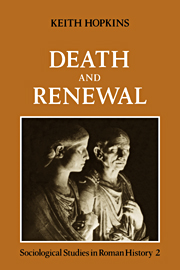Book contents
- Frontmatter
- Contents
- List of tables
- List of figures
- Preface
- Abbreviations
- Dedication
- Map
- 1 MURDEROUS GAMES
- 2 POLITICAL SUCCESSION IN THE LATE REPUBLIC (249–50 BC)
- 3 AMBITION AND WITHDRAWAL: THE SENATORIAL ARISTOCRACY UNDER THE EMPERORS
- 4 DEATH IN ROME
- Bibliography
- Index of subjects
- Index of proper names
- SOME OTHER TITLES FROM THE CAMBRIDGE PAPERBACK LIBRARY
4 - DEATH IN ROME
Published online by Cambridge University Press: 08 January 2010
- Frontmatter
- Contents
- List of tables
- List of figures
- Preface
- Abbreviations
- Dedication
- Map
- 1 MURDEROUS GAMES
- 2 POLITICAL SUCCESSION IN THE LATE REPUBLIC (249–50 BC)
- 3 AMBITION AND WITHDRAWAL: THE SENATORIAL ARISTOCRACY UNDER THE EMPERORS
- 4 DEATH IN ROME
- Bibliography
- Index of subjects
- Index of proper names
- SOME OTHER TITLES FROM THE CAMBRIDGE PAPERBACK LIBRARY
Summary
INTRODUCTION
When a Roman noble died, his funeral cortège comprised relatives and friends, hired actors wearing waxen masks of the dead man's famous ancestors, professional mourners wailing loudly and shouting out his exploits, and by contrast troupes of boisterous satyr dancers, all accompanied by flutes and horns (Dionysius Halicarnassus, Roman Antiquities 7.72). The corpse was carried to the forum, and was placed, usually upright but sometimes reclining, on the raised platform (rostra) from which public orations were delivered. The dead man's eldest son then gave a funeral speech, in which he praised his father's exploits and those of his ancestors. The historian Polybius, who lived in the second century bc, has given us a detailed description.
After the burial… they put the image of the dead man in a conspicuous position in the house, enclosed in a wooden shrine. This image takes the form of a mask, which recreates the dead man's features and colouring so that it seems astonishingly true to life. These masks are displayed, lavishly decorated, at public sacrifices. And when a prominent member of the family dies, they are taken to the funeral procession and are worn by men who bear a close resemblance in stature and gait to the original. (6.53)
These actors wore the robes and insignia of the highest office which each ancestor had gained, purple stripes for consul or praetor, full purple for a censor, gold embroidery for a general who had been awarded a triumph (cf. Diodorus 31.25).
- Type
- Chapter
- Information
- Death and RenewalSociological Studies in Roman History, pp. 201 - 256Publisher: Cambridge University PressPrint publication year: 1983
- 4
- Cited by

